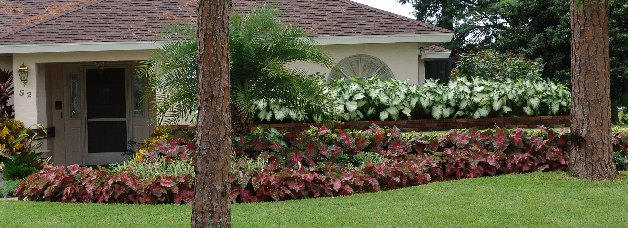Caladiums for Landscapers
| All Caladium varieties may be used for landscape purposes (interior, too!). However, certain varieties are more suited to certain landscape conditions than others (see table below). The following guidelines will aid the commercial landscaper to successfully incorporate caladiums into stellar landscapes. |

Planting Time:
Caladium bulbs may be successfully planted in the landscape throughout the tropics, subtropics and temperate climates of the world. In subtropical and temperate regions caladiums should be planted after the last frost in the spring when night temperatures are greater than 50 F. To jump-start the effect on the overall display, landscapers may choose to transplant either pre-finished or finished caladiums into their displays. When doing this make sure that the plants have been grown under the proper light to avoid excessive stress and sun burning in the installation.
Bulb Treatment:
No special treatments are recommended. Proper variety selection appropriate to the site of installation is key (see below).
Growth Regulators: No special treatments are recommended. Proper variety selection appropriate to the site of installation is key (see below).
Planting Depth: Bulbs should be covered with at least 1 ½ to 2 ½ inches of soil. This will ensure adequate soil moisture around roots as they emerge from the top of the bulb.
Soil Conditions: A well-drained soil is very important, as performance will be severely hampered in saturated soil conditions.
Watering:
Caladiums like water therefore be sure they are planted in an area that receives adequate irrigation so that they are kept uniformly moist.
Diseases:
The most common diseases are Fusarium and Pythium. The main symptom is root rot. Use fungicides such as Medallion to control Fusarium and Subdue to control Pythium. A fungicide drench should be applied 1-2 weeks after planting to control these fungal pathogens.
Stunted Growth: Make sure that bulbs are not stored at temperatures below 60°F (16°C), or above 90°F (32°C). Injury due to temperature exposure manifests itself in stunted (sometimes very slow) erratic growth even though the bulb does not show any injury at all.
Sunburn:
White and pink cultivars that have been grown during cloudy, early spring days and are suddenly exposed to high light intensity might show brown blotches on the leaves. In landscape plantings, we recommend keeping beds adequately moist to reduce sunburn and choose varieties appropriate to the planting site.
Leaf Spots:
A bacterial leaf spot may occur that is caused by a bacterial pathogen known as Xanthomonas. To prevent damage due to Xanthomonas, be sure plants are well spaced, that they receive plenty of air circulation and keep the foliage dry at night. Improper nutrition can also cause spotting of the foliage.
A pH higher than 7.0 is also known to cause brown spots.
Other Foliage Problems:
Pink areas in white cultivars like White Christmas usually are a stress related symptom. High temperatures (>100°F) can induce this symptom.
Light Intensity:
Caladiums can tolerate a wide range of light intensities. Some varieties perform quite nicely under continuous full sun conditions while others should be planted in partial (2-4 hours of full sun/day) or full shade. In the north (temperate climate) caladiums can stand more sun than in the south because of cooler night temperatures.
Fertilization:
In order to get continual growth after sprouting, caladiums should be fertilized. In sandy regions of the country, such as much of Florida, a good slow release complete fertilizer (Osmocote, Nutricote or other slow release) seems to work best.
Insect Control:
Caladiums are rarely damaged by insects or related pests. Occasionally worms can attack foliage. Dispel works well. Aphids occasionally appear near petiole bases and newly emerging leaves. Avid, Seven Dust and a number of other aphidicides work well. White flies have also been observed but this is not a normal occurrence.
Varieties:
All caladiums are useful in the landscape; however, some are more heat and sun tolerant than others. The following fancy leaved varieties can withstand full sun for the entire day:
White- Aaron, June Bride
Red- Fire Chief, Postman Joyner, Red Flash
Pink- Carolyn Whorton, Elise, Rose Glow
When designing landscapes, the natural growth habit of varieties is significant. Whereas most fancy leaved varieties have a relatively tall habit, certain strap leaved varieties make excellent border plants due to their mounding habits including:
White- White Wonder, White Pearl, White Dynasty, White Delight, Mt. Everest
Red- Red Frill, Heart’s Delight, Red Ruffles, Scarlet Flame
Pink- Puppy Love, Candyland, Starburst
Miss Muffet and the strap varieties Scarlet Flame, Day Dreamer and Blushing Bride have an intermediate habit and should be used in foreground plantings. While some caladium varieties tolerate full sun almost all benefit from 1-3 hours of morning sun.